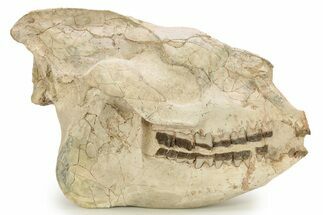This Specimen has been sold.
Fossil Squirrel-Like Mammal Jaws With Camelid Leg Bones - Wyoming
This specimen features two squirrel/mouse-like mammal jaws (mandibles) of Ischyromys typus that are naturally associated with the leg bones of a camelid (Poebrotherium sp.). The specimen was collected from the the White River Formation in Wyoming and would be approximately 30-34 million years old. The entire specimen measures 9.25 x 3.15". There are a few repaired cracks through the specimen.
Comes with an acrylic display stand.
Comes with an acrylic display stand.
This 60 centimeter (2 foot) long creature is one of the oldest rodents known. It had a squirrel-like or mouse-like appearance and already had characteristic rodent incisors. Ischyromys's hind legs were longer than its forelegs, which could have been used for other means than walking. Unlike most other mammals of its time, Ischyromys was probably arboreal, primarily living in trees.
Poebrotherium (meaning "grass-eating beast") is an extinct camelid that roamed North America between the Eocene and Miocene epochs. They were smaller than modern camels, about the same size as a modern sheep, and fit in the place of deer or gazelles in the White River fauna. Despite their name, it is believed that grass was likely not their primary food source but they were instead browsers, feeding on various foliage and berries. Based on bite marks in bones, they were likely preyed on by Archaeotherium, an extinct boar-like entelodont which was also prevalent throughout the White River ecosystem.
SPECIES
Ischyromys typus & Poebrotherium sp.
LOCATION
Converse County, Wyoming
FORMATION
White River Formation
SIZE
Entire specimen: 9.25 x 3.15"
CATEGORY
SUB CATEGORY
ITEM
#269861
We guarantee the authenticity of all of our specimens.
 Reviews
Reviews












